

Dante Zakhidov - NanoJapan 2013
Rice University
Major/s: Chemistry
Anticipated Graduation: May 2015
NJ Research Lab: Endo Lab, Shinshu University
NJ Research Project Poster: Edge-Enriched Graphitic Anodes by KOH Activation For Higher Rate Capability Lithium Ion Batteries
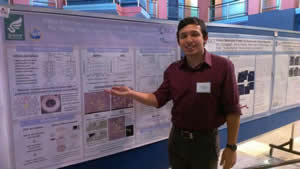
Why NanoJapan?
Scientific research and the quest for knowledge is a fundamental and unifying characteristic of human development. International collaboration is a vital part of this scientific process as it not only promotes discovery through exposure to new ideas but also strengthens cultural understanding. The NanoJapan program allows inexperienced, but highly motivated and bright undergraduates to pursue their passions in the interdisciplinary field of nanotechnology by challenging them to research, live, and learn in an unfamiliar but wonderful new setting. Through this program, students will mature both academically and culturally through a realistic representation of scientific research as well as interactions with seemingly different, but like-minded peers.
I applied to this program because I believe that this type of experience is not only valuable but crucial for students in our globalizing world. Academically, I will be able to balance my chemistry focus with exposure to broader ideas. I am keen to participate in nanotechnology-related research as it stands at a cross-point of multiple scientific disciplines. Working with Japanese students and faculty will allow me to learn new frameworks and technical tools to creativity tackle various scientific challenges. In addition, I am excited to form life-long friendships with all the colleagues I will be working with through the NanoJapan program. In the future, once we have matured in our respective fields, I will be able to collaborate with these friends and solve new problems.
My goals for this summer are to:
United flight 7 landed in Narita International Airport (NRT) at 2:05 pm on a bright and sunny day in Japan. I was expecting Tokyo to be like any other city – tall, noisy, crowded, and dirty. Narita is located 45 minutes outside of Tokyo, so we had to take a bus ride into the city. This gave us a perfect chance to look at the sprawling and massive capital of Japan. I was surprised to find that Tokyo’s skyline is not dominated by towering skyscrapers, but rather consists of many tall business and residential complexes. Unlike American cities, there is no distinct downtown center but rather many districts that are known for various specializations. After settling down at the hotel, Packard-sensei gave us a tour of Azabujuban, the district we were staying in. Walking around the streets, almost everyone instantly remarked on how clean the streets were. Subway steps, street corners, store fronts, and sideway alleys – all of them spotless. Japan has the highest per capita rate of vending machines in the world but you would be hard pressed to find a stray plastic bottle on your daily commute. However, even more remarkable is the fact that there are almost no public trash cans. If we wanted to throw something out, we had to wait until we got back to our hotel room. It was obvious that the cleanliness of Tokyo was indicative of the larger and more subtle cultural phenomena that we had begun to learn about. Rooted in tradition and sense of community, the Japanese are a highly homogenous people that value respect of self, family, and nature. Japanese morals and beliefs keep Tokyo clean.
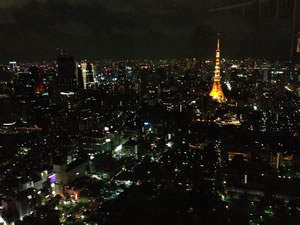
Tokyo City View: View of Tokyo tower and the Azabujuban district at night from the 52nd floor of Roppongi Hills Tower.
Furthermore, Tokyo is quiet. Despite being one of the largest cities in the world, you can walk through the streets and have peace of mind. This is also reflective of Japanese beliefs of humbleness and modesty. People value silence and calmness. As a result, music is not blaring from store way fronts, people do not chat loudly in the streets, and vehicles are built with softer car horns.
I was also surprised at the highly variable forms of architecture throughout all of Tokyo. Best described by our family friend, Yuko-san, Tokyo is a combination city. Combining both simple two-story houses with small alley streets to larger towering business buildings and shopping complexes. You can turn from a larger bustling intersection and enter a tiny street with old grandmothers sweeping away leaves from their doorsteps. Standing on the 52nd floor of the Roppongi Hills Tower and overlooking all of Tokyo, I could see the various patches of this combination city. Yuko-san explained this was due to the strong emphasis on tradition and reluctance to change lifestyles. While I have only highlighted just a few shallow differences, I have slowly begun to learn that they are representative of a larger cultural context. Nevertheless, I wasn’t caught completely caught off guard. Having family friends from Japan, I knew of the strong working culture and large pride that the Japanese have in whatever they do. This was confirmed in my daily interactions in the service sector. You will never find a cleaner, more efficient, and happier McDonalds. Even the cleaning service at our hotel takes their job very seriously. Perfectly preparing our beds every morning and precisely folding the bathrobes and towels.
My experience learning Japanese has been the most enjoyable language learning experience I have ever had. Trying to learn Spanish in high school and trying to strengthen my Russian skills in college, I was never inspired or motivated to do the course work. The Japanese language is just different enough and exciting enough, that I am able to immerse myself in the work. The alphabets are beautiful and writing well is a point of pride. The AJALT instructors are extremely friendly and highly motivating. The lessons are very well prepared with small class sizes, informative handouts, and engaging activities. I am constantly able to implement what I learn in class in my daily life. Learning the phrase “betsu betsu ni onegaishimasu” which means “can we pay separately” has helped me figure out the check situation in multiple restaurants. Learning simple phrases regarding location and time has also helped me find my way around the subway station. I am excited to continue learning for these next two weeks!
 The discussion with the KIP students was a lot of fun. The presentation by Inoue-sensei on the Toastmaster style of communication was a little bizarre and silly at first but everyone reacted to it well. Fast rotations due to short speech times allowed us to interact with many of the KIP students and forced lively and interesting discussions. Afterwards, the individual speeches and rating system allowed us to bond further. It was also interesting to hear the positions of the KIP students on the concept of whether silence is golden or on the differences in the communication styles between our two nations. When explained, everyone’s points were valid and showed many similarities between our cultures. I was able to exchange contact information with Teipei-san who was our guide in our weekend trip to Kamakura. Over that trip, I also became good friends with Mami-san and we have been discussing and comparing our musical tastes over email. We have also already hung out with Teipei-san, who showed us around Tokyo at night time. We plan on meeting up with Mami-san and Teipei-san further in the future.
The discussion with the KIP students was a lot of fun. The presentation by Inoue-sensei on the Toastmaster style of communication was a little bizarre and silly at first but everyone reacted to it well. Fast rotations due to short speech times allowed us to interact with many of the KIP students and forced lively and interesting discussions. Afterwards, the individual speeches and rating system allowed us to bond further. It was also interesting to hear the positions of the KIP students on the concept of whether silence is golden or on the differences in the communication styles between our two nations. When explained, everyone’s points were valid and showed many similarities between our cultures. I was able to exchange contact information with Teipei-san who was our guide in our weekend trip to Kamakura. Over that trip, I also became good friends with Mami-san and we have been discussing and comparing our musical tastes over email. We have also already hung out with Teipei-san, who showed us around Tokyo at night time. We plan on meeting up with Mami-san and Teipei-san further in the future.
Purikura: Stylized Japanese photo booth picture of Jordan, Ray, Mitch, JJ, Dante, Lila, and Meagan at the Sega Hi-Tech Arcade next to Shibuya station.
Public transportation in America is largely underutilized and volatile in terms of reliability and safety. Even in large urban centers and cities such as Houston, Texas, public transit is a hassle to use and not very effective. Coming to Tokyo, it is the complete opposite. Looking at the subway map you would be surprised to find this is the case. Comprising of over 13 different subway lines with over 100 stops, the Tokyo subway system looks like an organizational nightmare. However, highly organized, safe, reliable, convenient, and easy to use, the Tokyo subway is a civil engineering masterpiece with arrival and departure times accurate to the minute. In addition, public transit also consists of a bus, train (densha), and bullet train (shinkansen) system that are just as meticulously efficient. All of this stems from the Japanese principle of Doryoku or effort. As previously mentioned in my week one report, the Japanese people are highly prideful of themselves and whatever they do. The subway system is a perfect example of how they dedicate themselves to work for the success of the group. Of course, the accuracy and organization of the subway system is only reflective of one Japanese cultural value that makes public transit so convenient.
While in transit between Azabujuban (the district where we live) and the many sightseeing or academic destinations, we have been able to observe the unspoken rules of public transportation. Everyone is always extremely courteous and polite. When the subway arrives, people are first allowed to get off the subway before anyone attempts to board. People rarely talk out loud, even if sitting next to their friends. When they do, it is always concise and quiet. In every cart there is special priority seating for the elderly, disabled, and pregnant. Despite being allowed to sit in priority seating in the absence of those who it is reserved for, people prefer to stand and keep those seats open. During rush hours, there is a special cart designated for women only to prevent harassment from close proximity. The silence and peaceful atmosphere is further maintained by the activities that are socially accepted on the subway. People most commonly read a book, listen to music, fiddle with their phones, or sleep. However, they always use headphones when listening to music and always turn their phones on silent. These characteristics of the subway system reflect the Japanese value of Wa or harmony. In all situations, both public and private, the Japanese people try to keep a sense of order based on relationships between people, things, and nature. As a result, it is considered extremely rude if you talk on your cellphone in the subway (they somehow always get reception) or chat loudly with your friends. This principle of harmony also makes the subway safe. Women can feel confident using the subway by themselves at one in the morning. People can safely sleep without worrying about getting their things stolen. Ultimately, these different norms or rules almost always stem from cultural values and the practicality of the matter is simply enforced.
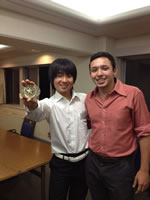
With Tepei-san, one of the KIP Japanese students
We have three Japanese teachers who teach us throughout the week, Kuzuoka-sensei, Sawa-sensei, and Sawane-sensei. They are all excellent instructors whose different teaching styles makes class interesting and fresh. That’s an impressive feat when you consider we learn Japanese for three and a half hours straight with only one ten minute break. Before we even arrived for the first day of class, all of our teachers had already memorized our names and were well versed in our hometowns, American universities, and Japanese institutions. The classes are highly interactive and materials/handouts are specifically tailored to the NanoJapan program. When discussing how to buy items, Sawane-sensei took us to the closest convenience store and made us purchase something in Japanese. For our Friday lesson with Shimojo-sensei, we went to the Edo-Tokyo museum and got to practice our Japanese while learning about Japan’s past. The next day, when we went to Sumo, some of our sensei’s joined us and helped us understand the national sport of Japan. One day, we went to the AJALT headquarters and got to practice our Japanese with other instructors who talked to us conversationally. Afterwards, we all got ice cream and enjoyed talking to each other. Overall, the accelerated Japanese language classes are very fun and informative. When I met with my family friend, Yuko-san, she was impressed with my Japanese and it showed me how much we learned. I hope to continue Japanese language studies in Rice.
U.S. Japan Relations by Mark J. Davidson of the U.S Foreign Service: Having taken a class called “Public Diplomacy and Global Policymaking in the 21st Century”; I found the talk by Mr. Davidson of the U.S. Embassy in Tokyo to be very rewarding and interesting. Mr. Davidson is an expert in the soft power of public diplomacy and stressed how important it is to first listen and learn before engaging and informing. In his candid talk, Mr. Davidson explained the relationship between U.S. and Japan, explaining the radical shift between war and friendship. Continuing into a contemporary context, he described major political issues as well as party tensions. Overall, he was very warm and humorous, inserting anecdotes about his own life and family. I am very glad we were able to hear him speak and I hope he continues speaking to NanoJapan students in the future!
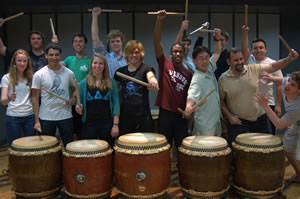
The NanoJapan 2013 Group tries out their Taiko Drumming Skills!
Minami Sanriku was one of the most beautiful places I have ever visited. Tall rolling hills covered in beautiful towering trees looked over a picturesque beach. Tufts of tiny islands spotted the horizon while white fishing boats lazily rested on a glistening blue ocean. However, the peaceful and carefree first impression of Minami-Sanriku was only partially true, a remembrance of times before 3/11. Just around the corner, a barren patch of land, once littered with multi-colored houses, was testimony of the powerful and unbiased force of nature. A single structure, with its red steel frame twisted and bent by the tsunami, lay memorial. It was a truly humbling and saddening experience.
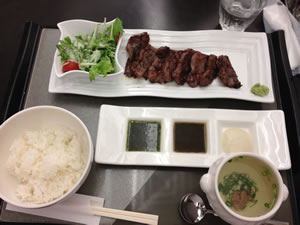
Eating gyutan, cow tongue, in Sendai – a local specialty
Visiting the kindergarten and elementary school had the greatest impact on me. Despite all of the sad things we learned about the area, seeing the faces of the smiling school children made me hopeful for the future of the Minami-Sanriku area. Foreigners are rare within Japan and even rarer in Minami-Sanriku. The children were all genuinely excited to meet you and enjoyed playing with you. I grew close to the kids while playing Japanese dodgeball and they decided that my nickname would be Mario. They choose Ron to be Luigi and they had fun calling us Mario and Luigi. The teachers told us that the students greatly enjoyed last year’s NanoJapan visit and were looking forward to our visit. It was great to see their excitement and know that we could help contribute to their happiness.
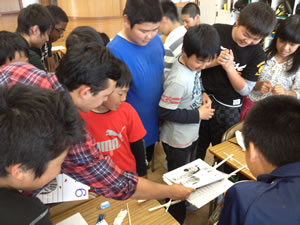
Testing the strength of a chopstick bridge built by a team of 6th graders in an elementary school in Minami-Sanriku
Before arriving in Minami-Sanriku,I had expected everyone to be quiet and reserved about the 3/11 incident. Instead, I was surprised to find that everyone was very open about that day. For the most part, it seems as though everyone had put it behind them and were focusing on the future. I found this to be very reflective of the Japanese mindset. For example, despite the American bombing of Hiroshima and Nagasaki, the Japanese people moved forward and set up critical alliances with America. Additionally, we had learned that people were bitter about the slow regrowth of the area and had felt that government had abandoned them. It was depressing to see that this was true. Even after two years, residents still lived in temporary housing despite being promised new homes. The JR train line to Sendai was the life line of the small fishing village and it isn’t going to be rebuilt. When talking with residents of the temporary housing, they said that government was side stepping the issue and mismanaging money.
Overall, the 3/11 disaster was a strong wakeup call for the Japanese people. We had learned that before 3/11, almost all Japanese people strongly approved of their government. However, because of the mismanagement of the disaster, lack of transparency in media, and bad regulations that allowed for the Fukushima incident, government approval drastically decreased. The Japanese people are more skeptical and careful. Additionally, it seems as though the people outside of the Tohoku have slowly begun to forget about people affected by the 3/11 incident. Major cities are full of advertisements showing happy and cheerful people from Tohoku but don’t mention the slow progress in regrowth. Of course, I don’t have enough experience communicating with Japanese people regarding 3/11 so this could be a misguided observation.
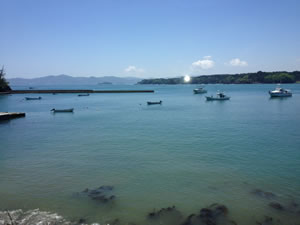
Picture perfect Minami Sanriku
I think the best way that the U.S. and Americans can help the Tohoku region recover, short of providing millions of dollars of funding, is to continue to visit and learn about the area. Minami-Sanriku could be a wonderful and luxurious tourist destination but the reluctance of the people to enter the sea out of respect for the dead is hindering growth in this sector.
I arrived in beautiful Nagano on a Sunday afternoon and a few members of the group picked me up from the train station. Communication was difficult and introductions were made in broken Japanese and broken English. Nagano is a smaller city compared to Tokyo or Osaka, so English is not commonly spoken. Once we arrived on campus (5 minute car ride from the station, 15 minute walk), they showed me my apartment and then took me to the student offices. The student office space serves as the main gathering point and is where all the students study and work during the day. Despite it being Sunday, many students from the lab were waiting for me and welcomed me to Nagano. We went out to eat delicious Okonomiyaki and conversation was less awkward and very fun. The first formal day was on Monday. I met Endo-sensei as well as Kim-sensei and Hiyashi-sensei. Kim-sensei discussed my research and crafted a project that could be managed in the short summer time frame. The rest of the week was mostly spent reading papers and catching up on my research project.
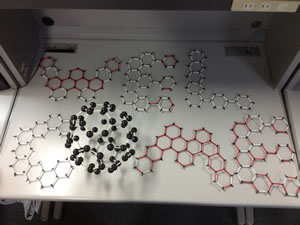
A Nanostructure Welcome: My labmates spelled out "WELCOM"E on my desk with graphene and a buckyball on my first day!
After a week here, I am really glad I got chosen to research in Nagano. The lab group consists of 28 members, all guys, from senior year in undergraduate to end of the master’s course. They are all 20-27 years old and we sit together in the student office space and eat lunch together. It’s like having 28 awesome brothers! It’s only been a week but it has been a blast. On Friday, Shinshu University had a sports competition festival. Our lab was entered into the Japanese softball bracket and the whole campus was busy playing sports. We managed to somehow get to the final game but lost by one run. Afterwards, dinner was sponsored by the university professors and we got to eat for free. They handed out awards and prizes and the group gave me the honor of collecting our second place trophy. I got to grow really close with my lab mates and also met a lot of other students around campus. Additionally, there are free Japanese language courses offered for all foreigners. I went to class and got to meet all the other international researchers. They invited me to a barbecue and on Sunday we all got together and ate delicious food. I had Mexican guacamole, America hamburgers, Indonesian saté, Chinese dumplings, Japanese scallops and squid, and some drinks form Bosnia and Chile!
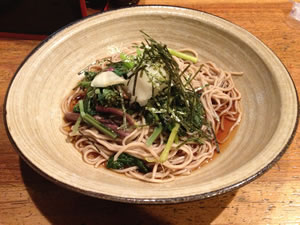
Soba – the Nagano Specialty: Eating delicious cold soba with mountain grown veggies right next to Matsumoto Castle.
My mentors are Sugamata-san and Yasue-san. They are both first-year master course students and are very nice and encouraging. Kim-sensei is overlooking my project and offering advice. Daily interactions usually include me speaking in English and the students working together to try to understand what I said. I communicate simple phrases in Japanese and try to learn a few words a day. It’s a great experience for both parties since I am forced to learn Japanese and they get exposure to English. Despite language barriers, communicating about research and technical topics is not too difficult. I was able to read several papers pertaining to my research project and this has helped me piece together what my mentors are explaining. However, sometimes the topic is confusing and difficult to explain and I have to take a leap of faith and move on.
Housing at the Ohta International Memorial House is amazing! It is a little bit pricey, comparable to prices in Tokyo, but the benefits and convenience are well worth it. My room is very large and has two queen sized beds. There is a large amount of desk space, a TV, a refrigerator, ample hanger space, and a personal bathroom. The room is actually bigger than my room at my house in Texas. The room is part of a bigger three-room suite where international guests and researchers stay. When there are no visitors, I have the entire suite to myself. Inside of this suite there is a large common room space as well as a kitchen with microwave and water boiler (no stove unfortunately). There is also a free washer and dryer which everyone can use. The Ohta International Memorial House is on campus and a mere two minute walk away from the lab and office space. The campus is also located right next to a supermarket and home value center so shopping is just a five minute walk away. I couldn’t have gotten a more perfect living situation!
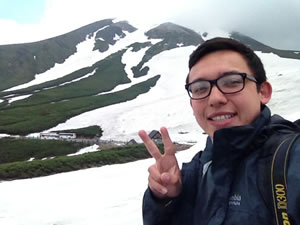
Adventure in Nagano: Me standing 3000m above sea level in Norikura Kogen. Took my first Saturday to travel to Matsumoto and the surrounding area. Nothing like snow in June!
Research Project Overview: This summer, I will be working on improving the capacity of graphite anodes in lithium ion batteries (LIBs). Rechargeable lithium-ion technology has become extremely popular in consumer electronics as it has a high energy density, no memory effect, and long cycle durability. The major three components of LIBs are the anode, cathode, and electrolyte. Graphite is the most commercially popular anode and works on the basis of intercalation to reach the formation of LiC6. However, the maximum theoretical capacity of graphite is 372 mAh g-1 and larger capacities are needed for next generation technologies.1 Advancements in battery technology have been slow (no Moore’s law here), but recent developments in carbon nanostructures have showed promise for a breakthrough. Unfortunately, reported results are still insufficient for practical applications, but this research has shown that the “edges of layered carbon are considered to be the gateway by which Li ions intercalate between graphite layers.” 2 The capacity of graphite is limited because the ratio of edges to the basal plane (sp2 hexagonal plane) is very small. My summer research will be focused on increasing the number of edges in graphite by potassium hydroxide (KOH) activation.
In a molten state, KOH vertically buries through the basal planes of graphite (making it look like Swiss cheese). These pits and holes increase the number of active edges and allow more lithium ions to intercalate into the graphite plane at one time. Graphitic activation by KOH takes place at 750°C inside of a furnace with flowing Argon gas. After a cleaning process, the graphite anode is assembled into a coin cell with lithium metal for the cathode and EDEC as the electrolyte. For my project, I will be looking at what concentration of KOH provides the best capacity. I will activate graphite with 100%, 200%, and 400% KOH by weight. The goal is to analyze the capacity and then characterize the material with SEM, TEM, RAMAN, XRD, and BET.
I am really excited about this project because of all the new techniques that I will learn. I have already learned how to activate graphite, construct a coin cell, and measure the capacity of a battery. I will need to learn how to use SEM, TEM, XRD, RAMAN, and BET but this will happen over the course of the summer. I have read several papers regarding intercalation and lithium ion batteries but I am interested in learning all of the theoretical aspects of my project.
Life in Nagano is splendid. Research has been intensive but interesting and fun. I have become good friends with all of my labmates and my living accommodations are pretty much perfect. The only down side was that my apartment doesn’t have an Ethernet connection or Wi-Fi. However, on the first day, I was provided with a 3G Wi-Fi laptop stick that was fast enough to browse the internet and send emails. This was perfect for me as the student office space has a fast internet connection for everything else and was only a 2 minute walk away. Unfortunately, neither my apartment nor the student office space has open Wi-Fi for my smart phone to connect to. However, one day, I noticed that if I stood in a certain part of my apartment, there was a university Wi-Fi signal. While lack of Wi-Fi access was not a problem by any means, it would have been nice to utilize my smart phone and the apps that I had on it. I asked my mentor if it would be possible to access that Wi-Fi, and he told me to ask Kurata-san, the lab secretary.
I went to Kurata-san and asked if it would be possible to access the Wi-Fi at my apartment. This led to a lot of confusion for a variety of reasons. When I showed her my phone, she initially thought that I was not able to call anyone due to lack of Wi-Fi. This escalated the situation as she worried I had no forms of communication for the past few weeks. I made sure to explain to her that this was my American phone and that I was only using it for Wi-Fi capabilities and pictures. I showed her my Japanese phone to dispel any further worries. This initial confusion only served to complicate the seemingly simple question that I wanted to ask. Next, she called the apartment complex and asked about possible Wi-Fi connections, but they told her that there were no Wi-Fi connections available for tenants. I thanked her for going through so much trouble and left to continue my experiments. I decided that I must have inadvertently found a Wi-Fi connection not intended for my floor and thought nothing of it.
The next day, my mentor tells me that Kurata-san apologizes for the lack of Wi-Fi and wanted to ask me if I wanted to move to a different apartment that had Wi-Fi and more amenities. I was mortified. I had only wanted to ask if I could access Wi-Fi for my smart phone. After thinking about it, I realized that the term Wi-Fi probably created some confusion. First, there was the 3G Wi-Fi stick that I received at the beginning of my research that my computer could use to wirelessly reach the internet. Second, there was a Wi-Fi router that broadcasted a signal that inadvertently reached me. Kurata-san probably thought that my question about Wi-Fi for my phone meant that I was un-satisfied with the Wi-Fi stick that I had received earlier. Per Japanese custom and hospitality, Kurata-san wanted to make sure I was as comfortable as possible. I ran to her desk and told her that my apartment accommodations were extremely convenient and that the Wi-Fi was not a problem.
Despite this, the next day I was called to Kurata-san’s office and she gives me Endo-sensei’s personal Wi-Fi stick. Endo-sensei told me that I should use it. I was even more mortified and embarrassed. I told them that it was ok and I didn’t need it. They insisted. In hindsight, I should have resisted harder but I was too embarrassed and wanted to get out of there as fast as possible. A few days later, Kurata-san calls me asking for the Wi-Fi stick back saying Endo-sensei needs it. I gave it back right away and she then hands me a new 4G Wi-Fi stick. At this point, I knew I was stuck (too late to refuse it) and accepted it after apologizing profusely for being such a nuisance and thanked them for their kindness.
What I thought would be just a simple question with a yes or no answer turned out to be an embarrassing situation. Language barriers and my lack of cultural understanding complicated the issue. Next time, I probably wouldn’t bring up the issue since it wasn’t of much importance. I would also ask friends in the lab for their advice and input.
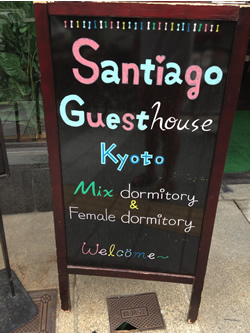
Meagan, Ron, and I took a weekend trip to Kyoto to explore the city. We stayed at the Santiago hostel for three days and two nights. It was clean, convenient, and cheap! It only cost 33 dollars for two nights.
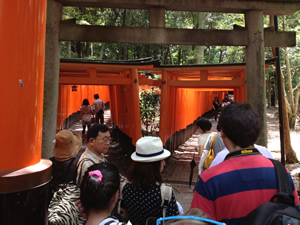
At the beginning of the Fushimi Inari-tasiha shrine in Kyoto. The orange gates are called tori and there are over a million tori on the way to the top of the mountain! Xavier, Ron, Meagan, and I made the trek to the top and it took over two hours.
Research Update: Over the last week I have focused on the fabrication of lithium ion batteries using activated graphite. I have included an excel file that I use to keep track of my research. One of the variables we are exploring in the activation of graphite is degrees per minute. The furnace used in the activation of graphite can heat up a set time interval. We are looking to see if the speed of graphite activation affects the size, depth, or number of holes created by molten KOH. Furthermore, during capacity testing, we are applying different currents to see its effect on charge and discharge as well as robustness. Overall, there are many coin cells that need to be made, tested, and characterized. Activation and cleaning is a 3 day process. Anode fabrication takes two hours and subsequent drying takes 12 hours. Coin cell fabrication occurs in the glove box and takes one hour followed by 12 hours of equilibration. Finally, a coin cell test takes anywhere from one day to 2 weeks depending on the set current. I stagger the fabrication steps and usually do one of the steps every single day. Fabrication is highly variable as the lithium ion batteries are very fragile and susceptible to shock and exposure to atmosphere. Even though the work is repetitive, it is fun and interesting as I try to master the fabrication steps. Many of the instruments in the lab are booked or broken so I will not start SEM until Friday. I have not processed any results from capacity experiments because there is a problem with my computer and the excel macro. We hope to resolve it by the end of the week. Furthermore, because there is so much work to be done, I have decided to do experiments over the weekend to stay on track.
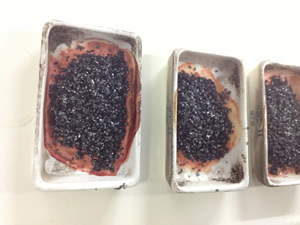
Activation of graphite by potassium hydroxide at 400 percent by weight. We messed up but made some cool colors!
Week 6: Research in Japan vs. in the U.S.
Hierarchy is the biggest rule in the lab. Everyone’s rank is clearly defined from B4 (4th year bachelor) to M3 (3rd year master) and then finally to doctoral candidates and postdocs. Within the office space itself, the desks are separated according to seniority. Master students have the more secluded back half while the bachelor students sit up front. The doctoral candidates and postdocs have their own private section while professors have their own rooms. Everyone is also addressed based on their seniority. The professors and assistant professors are always greeted politely with a “sensei” attached to the end of their family names. Anyone of a higher or similar rank is addressed with a “san” and anyone of lower rank is addressed with a “kun”. As a B2 level student, I am of course addressed as Dante-kun. The importance of hierarchy comes from Japanese principle of ningen kankei or human relations. This can be seen both in the respect for elders as well as social structure in the work place. I have noticed that the B4 students always make an effort to respect the master’s students. Based on talks during the orientation period about Japanese culture, I had expected this to be the case. However, after spending a few days in the lab, everyone seemed so close and familiar that I believed that hierarchy was only a formality. Nevertheless, after closer inspection and more exposure, I found that it played a far bigger role than I initially saw. For example, when we were coming back from the grocery store with supplies for a barbecue, the B4 students took the grocery bags from the masters students and carried it themselves. The posture of the student’s changes based on who they talk to and their tone and infliction also change. A few times I have made the mistake of calling a senior student with the suffix “-kun” because everyone else was addressing him that way.
I haven’t actually seen anyone disagree on an issue, but that’s because they don’t do so very publically. This goes back to the concept of rikai or understanding where people try to minimize disagreement and embarrassment. Whenever someone tries to correct me they always do so very indirectly. Their tone becomes lighter and they usually look at me very inquisitively as though they are seriously considering the credibility of my mistake. Their response is usually peppered with many “maybes” and “I thinks”. If I make a mistake publically, they don’t point it out right away but wait until a more private moment.
Some other rules include courtesy in the student office. Unlike America, it is completely appropriate to take a nap at your desk. If someone is taking a nap, people tend to be quieter. Headphones are always worn when listening to music or watching a video. Timeliness is also very important. Group meetings start strictly at 9am and if someone is late, they are always out of breath, showing that they were trying their hardest to get there as fast as possible.
Teamwork and sense of team are highly valued in the lab. On campus, people identify themselves based on the lab they work in. My lab always eats together and does activities together. One Friday there was a softball tournament, and all the teams were based on research groups. Right now, all the bachelor students are busily preparing for their master degree entrance examination. All the master students are busily helping them. They hold mock interviews for the bachelor students and help edit their essays, sometimes up to eight or nine times. In my own research, my mentors take an active role in carrying out experiments. One of my mentors only works during the night (7pm to 7am) and sometimes conducts experiments for me without telling me. At first I was confused and thought I wasn’t working hard enough but he explained to me that he was just helping me. This is very different from American academic groups where researchers are highly independent. Hard work and long hours are also extremely valued. All of my lab mates are always tired and many of them come into the lab on the weekends. In America, I feel like this is also equally expected amongst researchers. Academic and experimental work generally requires long hours and hard work.
Another difference between research in Japan and America is that Japanese students only have the option to join a research group in their senior year of their undergraduate degree. For them, joining a research group is the same as committing to a master’s degree in that group. Once they join, it is extremely difficult to change topics or groups. In America, students can already be exposed to research in high school. Joining a research group is not binding and not indicative of further higher education. Furthermore, based on my experience in Shinshu University, research groups are more focused on providing education to students. Research groups are very large and mostly filled with bachelors students and masters students. My group only has one doctoral candidate and one postdoc. This is unlike American research groups that I have been exposed to where there are many more doctoral candidates and postdocs. As an undergraduate student in a new country, I find the Japanese system very welcoming. However, overall, I believe that both systems have their own merits and don’t have a preference.
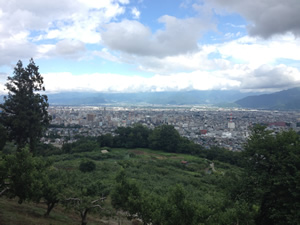
Getting lost - I decided to go on an adventure and picked a random hill to try to run up. Got lost but ended up finding myself in an apple orchard. The amazing view from the end of the road!
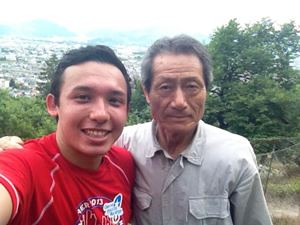
I met the caretaker and owner of the farm. He only knew Japanese but I was able to talk to him about the basics! He wanted to offer me an apple but he explained they would only be ready in August.
Research Update: I have continued to make coin cells and test them for their capacity. I have separately attached an updated checklist of my experiments to show my progress. I just recently conducted Raman and XRD measurements of several of the activated graphite samples. The Raman measurements showed characteristic G and G’ peaks and were very clean with no D peak. The XRD measurements for the 100% KOH by weight activation were different that the 200% KOH by weight activation but we haven’t processed and analyzed the data yet. This next week I will do SEM characterization for the first time.
This week I also processed results from capacity testing of various coin cells. The data was largely disappointing as most of my coin cells died or showed very poor performance (much lower than the theoretical capacity of graphite at 372 mAh/g). We do not know whether this low performance was due to bad fabrication techniques, old materials, or other reasons. Right now we are testing a control experiment where the graphite was only heat treated at 720°C and not activated with potassium hydroxide. We will be able to better assess the results from the activated graphite with this control experiment.
This may sound silly, but one day I found myself holding the most amazing writing utensil. It was a click-to-write, 0.5 millimeter pen with a comfy grip and a “Zebra Sarasa Clip”. It wrote like heaven and clipped real well too. Smooth and sexy flowing lines with crisp black ink that looked beautiful when contrasted against the white paper. After some Google searching, I discovered that these magnificent creations are called rollerball pens, and I wasn’t the first to marvel at their awesome powers. These pens use a little thing called gel-ink technology and needless to say, were developed in the-one-and-only Japan. Basically, I was in constant awe of these things. I found that I had unconsciously started to improve my handwriting because I was writing slowly and more deliberately. The ink made everything so fresh and so clean. The better I wrote, the better it looked, and the happier I was! Whenever I held the pen, I would spontaneously start writing in cursive on every surface I could find. I decided to capture the momentum and devote myself to an improved handwriting goal for 2013. I visited Google again and, lo and behold, thousands of self-directed handwriting improvement guides for the scripturally challenged. I subscribed to non-other than Nan Jay Barchowsky of the BFH method and have been steadily improving my handwriting ever since. Apart from day to day writing, I practice my down strokes and upstrokes for 15 minutes a day. Mrs. Barchowsky says that anymore will just lead to frustration and backwards progress. It’s helped me with my habit forming skills and directed my efforts for more productive time usage.
Nevertheless, productive usage of time is still my biggest personal challenge. I waste so much time on social media and looking up silly pictures of cats that I find myself face palming every single night. I get into lab and of course I have to check my email and facebook first. That leads to thirty minutes of inefficiency and I lose my drive to start another bout of device fabrication. I get back from lunch, check email and reddit. Get done with experiments? Go on the internet. If you add up all of the thirty minute gaps that I have wasted on Facebook, I could have invented the next Facebook by now. Recognition of the problem is the first step in solving it but it’s pretty hard. Even as I was writing this reflection, I found myself alt-tabbing to chrome and checking for notifications. The handwriting is a nice change but it is only 15 minutes a day. I recently just started learning how to code Python at Codeacademy in another effort to make a good habit. However, the pace is kind of slow and I find myself getting bored. I am sticking with it until the advanced topics at least.
Research is progressing well. I am not getting improved results despite theoretical suggestions that show I should be. A million things can go wrong during device fabrication so I don’t know if it’s just my inexperience in the glove box or whether I am getting bad results for an actual interesting reason. We are working on deducing that. Research is never ending and there many variables I can change to investigate my work more extensively. However, I believe I will get enough results by the end of the summer to make basic conclusions about my work.
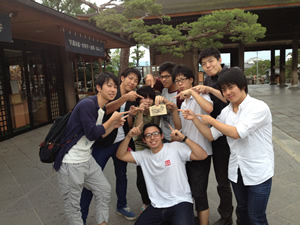
Ganbatte Kudasai!: A day before the master degree entrance examination, my labmates and I went to Zenkoji-temple wishing for good luck. We all signed an Ema which we left hanging at the temple.
Japanese language progression is at a minimum unfortunately. Every day I tell myself that I want to learn more but I never get around to it. I am taking a Japanese class provided by the university but it only meets for one hour a day and for two days a week. I greatly admire my sensei but he is 87 years old and teaches at an extremely slow pace. I have four classmates who are doctoral or post-doctoral researchers. Almost all of them have been in Japan for more than one year. My proficiency is pretty bad. I know all the basic sentences rather well. I have a decent understanding of the grammatical structure but still mess up my particles. The biggest thing I need to work on is vocabulary. If I knew more words, I would be able to understand everyone a lot better.
Trip to Okazaki: This weekend I visited the city of Okazaki in the Aichi prefecture. When I was just a baby, my family lived in Okazaki while my father conducted research in the Okazaki Institute of Molecular Chemistry (OIMS). During that time we became close friends with Mitchiko Mitsuhashi who was a kimono-sensei and hostess of international researchers. I got to visit Mitchiko-san, see the house I used to live in, and the pre-school that I attended! Despite her age, Mitchiko-san is still very independent and energetic. Just 10 years ago, she raised money and enlisted volunteers to plant 86 Sakura cherry blossoms along the river outside of her house. Twice a year, she holds a garage sale and sells donated items to raise money for the garden. After 3/11, she began giving all of the proceeds from the garage sale to disaster victims. She has raised over 10,000 dollars! I am giving all of these examples to show the warmth and caliber of her character. It was great to visit her and see so many important parts of my family’s history. I met up with my father’s research mentor and he showed me OIMS. I got to see the office in which my dad worked 20 years ago! We had a tempura frying dinner one night and Indian food the next. During dinner, Mitchiko-san would bring out photo albums and we would look at pictures of when my family lived in Japan. It was cool to see my family eating dinner at the table that I was sitting at right then. I never felt more at home! By the end of trip, I began calling Mitchiko-san my Nihon no obachan or Japanese grandmother. It was a blast and probably my favorite part of my stay in Japan so far.
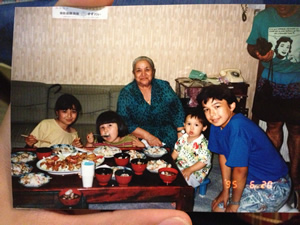
Blast from the Past!: All the kids and my grandmother eating dinner with red miso soup back in the day! I’m the little kid sitting on the blue chair.
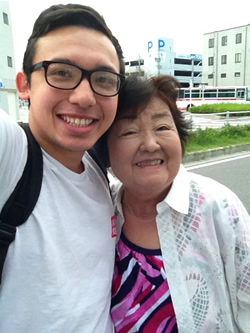
My Nihon no Obachan (Japanese grandmother)! She is the sweetest!
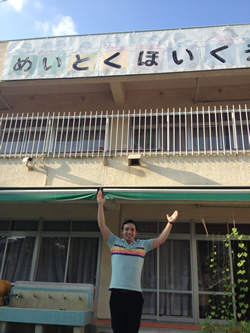
Visiting the kindergarten that I attended when I was just a baby!
Research Update: After talking to Kim-sensei, my mentors told me that I won’t be focusing on the temperature per minute variable anymore. From the beginning, I had a lurking suspicion that this variable wouldn’t really to contribute to anything. I couldn’t see the rate of KOH activation being a major factor in improved capacity but the enthusiasm and fervor with which my mentors tackled the activation, I didn’t want to press it. I tried once, but the language barrier made it difficult for me to express my concerns. This lightens up my workload considerably which is good. Instead, based on recommendations from the supercapacitor group, we are further heat treating the activated graphite at 1000 °C for 30 seconds. We hope this will increase the capacity past the theoretical capacity of graphite. I have updated the Lithium Ion Battery Checklist to reflect these changes.
To be honest, I have not processed any new data or compiled my XRD, SEM, or RAMAN data yet. I have to do this first thing when I come back from Okinawa. I promise by next week’s report that I will have this data included. The XRD data we took comparing 100%, 200%, and 400% by weight KOH activation showed a shift in the characteristic graphite basal plane as we went from 100% to 400% which is interesting. When we took SEM pictures, we mistakenly used gold to increase the conductivity. This probably covered up the holes created by KOH activation which we assume to be around 10 nm in diameter.